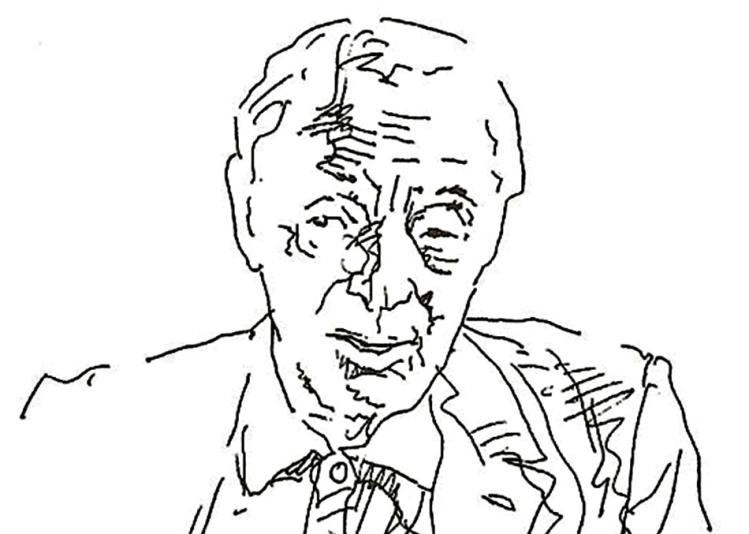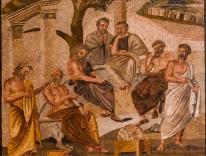
In Ben Lerner’s 2011 novel Leaving the Atocha Station, Adam Gordon—a John Ashbery–loving, Jacques Derrida–spouting young poet—asks himself a rhetorical question: “Who wasn’t squatting in one of the handful of prefabricated subject positions proffered by capital or whatever you wanted to call it, lying every time she said ‘I’?”
The assumptions underlying this question are the assumptions underlying much twentieth-century critical theory: the idea that the self is determined by forces beyond it; that taste and consciousness aren’t expressions of our deepest being but the traces of history and ideology written on us; that terms like “the self” and “our deepest being” and even “the human” are false abstractions that need to be exposed rather than explored. These ideas, which we might describe loosely as antihumanist, claim that the story told by post-Enlightenment philosophy and art—the story of individuals choosing and loving and suffering and growing—is false. The “I,” such thinkers argue, is a lie.
In The Age of the Crisis of Man: Thought and Fiction in America, 1933–1973, Mark Greif examines how we got to this moment of antihumanism. More specifically, he argues that we can only understand how we got to antihumanism by looking back to a very particular moment in American cultural and intellectual history. During a period of roughly forty years, Greif argues, American thinkers feared that man’s irreducible nature, the identity that remained constant despite apparent differences, faced a serious threat: “human nature,” it seemed, “was being changed, either in its permanent essence or in its lineaments for the eyes of other men.” This anxiety could be seen in the many book titles, almost too many to count, that invoked a crisis of man and his meaning: Reinhold Niebuhr’s The Nature and Destiny of Man (1943); Herbert Marcuse’s One-Dimensional Man (1964); Joshua Heschel’s Who Is Man? (1965). Greif lists several more.
Why was this question of what Greif calls “fundamental anthropology”—what is man?—asked with such desperation and regularity at this specific moment? To answer this, Greif argues, we must look to the “many streams of thought and writing that shape a public philosophy.” Greif, a founding editor of n+1, has written on politics, philosophy, and literature before, and his intellectual versatility shows in this book. He shifts around constantly, moving back and forth between works of art and works of philosophy, reading theology (Niebuhr and Jacques Maritain), literary criticism (Lionel Trilling and Malcolm Cowley), anthropology (Franz Boas and Claude Lévi Strauss), and fiction (Ralph Ellison and Saul Bellow). Throughout, he shows how the period’s thinkers circled around a series of common questions: What is man? Where has he gone wrong? And what can be done to save him?
W. H. Auden ended a 1930 poem with the assertion that things were about “to disintegrate on an instant in the explosion of mania / Or lapse for ever into a classic fatigue.” Explosion or fatigue, upheaval or enervation: these seemed the only options in the 1930s. Global capitalism was spreading, along with the shocks and crashes that it is heir to. So also was totalitarianism, which sought to control not just human populations but human souls: as Hannah Arendt put it, it desired not “the revolutionizing transmutation of society, but the transformation of human nature itself.” Finally, dramatic advances in technology made it seem that humanity would either become more machine-like or destroy itself by its own hand.
On many fronts, the humanist, universalist idea of man appeared under threat, and so philosophers, in book after book, began discussing what exactly it was that needed protecting. Did mankind’s essence lie in his sinful “inclination to transmute his partial and finite self into the infinite good,” as Niebuhr claimed? Or did it reside in our access to a storehouse of timeless ideas and concepts, as the popular defenders of the Great Books program argued at the time?
Whatever the particular way of framing the question, all of these crisis-of-man books assumed that there was an abstract human nature and that it was of urgent importance that this nature be preserved. Greif calls this crisis-of-man talk a “maieutic discourse.” By this he means a discourse that doesn’t offer a singular answer to the question, “What is man?” Rather, it hopes that the very act of posing the question will bring into existence the thing that is being questioned—namely, man’s essence. By asking what man’s nature is, the existence of man’s nature is established. (Greif borrows “maieutics” from Plato’s Theaetetus, where Socrates defines “his dialectical method of questioning as techne maieutike, ‘the art of midwifery.’” In other words, a style of questioning that helps bring forth new knowledge from another, just as the midwife helps bring forth new life from another.)
If crisis-of-man discourse arose first in philosophical circles, it quickly spread outward, making itself felt in many of the period’s strongest works of fiction. The third and, to my mind, most original section of Greif’s book shows how Ralph Ellison, Saul Bellow, Flannery O’Connor, and Thomas Pynchon all used the crucible of fiction to test the possibility of a universal essence of man. As Greif writes,
To discover this abstract man, [these writers] had to know first whether the identity as Jew or black or, indeed, any subset of men, any category by which men would be recognized, was a hindrance or an aid to reaching the purely human state. If there was a human being as such, what did it have to do with always being marked as something besides the generic ‘person,’ being named, being already, as it were, outlined by the ways others will recognize you?
What happens to abstract man, in other words, when it runs into the shoals of particularity—of race, ethnicity, history, class, and gender?
In a complex and thrilling interpretation of Invisible Man, Greif traces the subterranean influences on Ellison—Communism and Transcendentalism, Joyce and Hegel—and moves toward the novel’s brief moment of illumination for the unnamed narrator: “The crowd sweated and throbbed, and though it was silent, there were many things directed toward me through its eyes.... And as I took one last look I saw not a crowd but the set faces of individual men and women.” From crowds to individuals, from Man to men and women: Greif reads Invisible Man as a defense of “nominalism”—and thus as a critique of the whole crisis-of-man enterprise. He argues that Ellison’s novel shows that “categories and abstractions have no real existence. One tries to apply universal names to people and clasps the air. Only individuals exist—and the categories that would cover more than one of them are illusory.” Likewise, Greif sees Bellow’s Dangling Man as showing the impossibility of eternal dangling—that is, the impossibility of remaining forever free from the ties of ethnicity or family.
Readers of this magazine will be interested to know that, while Greif’s analysis of Flannery O’Connor can be sharp (for O’Connor, “liberalism forgets all mysteries in a great deceptive mush”), it isn’t as well integrated into the overarching argument as the sections on Bellow, Ellison, and Pynchon.
***
So, what happens when abstract man encounters the shoals of particularity? It sinks, according to Greif, taking faith in universal essences with it. The book’s final section, entitled “Transmutation,” charts the slow death and long afterlife of the American discourse of man. As Ellison proved, race was the fly in the ointment of crisis-of-man rhetoric, and this fact only received further confirmation in the civil-rights era. Malcolm X argued that appeals to universal brotherhood were often a screen for white privilege: as Greif puts it, “there was no background colorless universal, only different colors.” Second-wave feminism likewise showed all that had been elided in the talk of universal man—namely, half the human population.
This is one of the moments where Greif is marching through thorny historical ground. After all, the civil rights and feminist movements were so successful not despite but because of their commitment to concepts of the human: Martin Luther King Jr. imagined a future in which blacks and whites joined each other at the shared “table of brotherhood,” while the principal argument of feminism, both first- and second-wave, is that women are human beings, with all the rights that come with such a designation. Greif admits this, seeing King and others as making the pragmatic decision to use a flawed rhetorical tool for good purposes. But it’s hard to see how any argument for rights could succeed without this tool, and this fact might suggest that the tool is less flawed than Greif thinks.
Still, Greif is correct to argue that the 1960s saw many thinkers back away from all essentialist discourse. He shows how “the recognition of a tyrannizing uniformity and concealment of difference in the rhetoric of man” created a philosophical and cultural vacuum into which antihumanism flowed. Where crisis-of-man thinkers had emphasized man’s universal nature, antihumanists like Michel Foucault argued that such nature was really just contingency dressed up as essence. Where traditional humanists defended universalism, Lévi Strauss and others celebrated particularism. Where theologians spoke of man’s irreducible metaphysical grounding, Derrida sought to destroy metaphysics. The age of the crisis of man, in short, prepared the way for the age of the critique of man.
Greif sees the passing away of abstract man as a positive development. His careful attention to the flaws at the core of this universalizing project prove to him the flaws at the core of all universalizing projects: “Anytime your inquiries lead you to say, ‘At this moment we must ask and decide who we fundamentally are...’ just stop. You have begun asking the wrong analytic questions for your moment.” For “your moment” only, or from now on? Greif does not quite say, but his book strongly suggests that we’ve outgrown the old humanistic anxiety about universals—and good riddance.
Speaking not as a philosopher but as a literary critic, I see a problem here. As the best poets acknowledge, the world is built out of the particular: see, for example, Hopkins’s vision of the concrete, individuated “rose-moles all in stipple upon trout that swim.” But just because the world is built out of particulars doesn’t mean that there aren’t also universals. Again, think of Hopkins: the particularity of a thing, its haecceitas, does not preclude the universal but is the way to the universal. As Hopkins writes,
As kingfishers catch fire, dragonflies draw flame;
As tumbled over rim in roundy wells
Stones ring; like each tucked string tells, each hung bell’s
Bow swung finds tongue to fling out broad its name;
Each mortal thing does one thing and the same:
Deals out that being indoors each one dwells;
Selves—goes itself; myself it speaks and spells,
Crying Whát I dó is me: for that I came.
“Each mortal thing”—that is, each particular creature—reveals both its singular self and what kind of thing it is by its characteristic activity. And kinds—kingfishers, dragonflies—are universals. So the particular and the universal are not necessarily at odds, and can relate to each other in more than one way. To insist on particularity, to dwell on difference, is not necessarily to deny the universal.
Whether or not you agree with Greif’s anti-essentialist critique of “the human”—and, as a humanities professor, I don’t fully—his book makes for exhilarating reading. The Age of the Crisis of Man shows that what we think of human nature—and whether we think there is such a thing—has profound consequences for every part of our culture, determining what kind of questions we ask and what kind of projects we undertake. Greif has written a work of real intellectual and moral force.
Please email comments to [email protected] and join the conversation on our Facebook page.
Share
Previous Story
'One Moment of Reality'
Next Story
Our Kids

